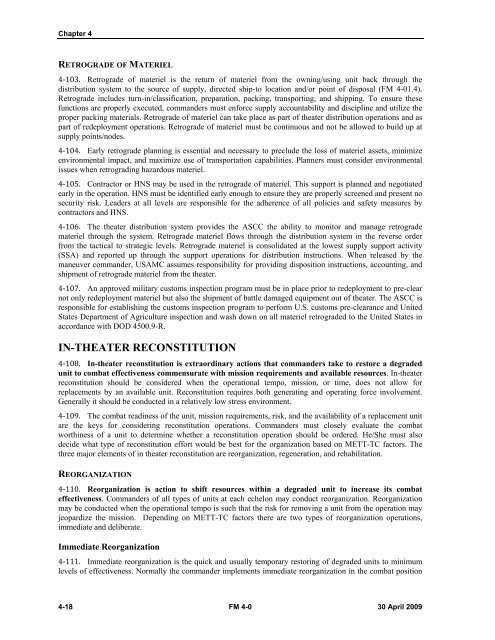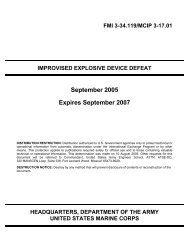FM 4-0, Sustainment - GlobalSecurity.org
FM 4-0, Sustainment - GlobalSecurity.org
FM 4-0, Sustainment - GlobalSecurity.org
- No tags were found...
You also want an ePaper? Increase the reach of your titles
YUMPU automatically turns print PDFs into web optimized ePapers that Google loves.
Chapter 4RETROGRADE OF MATERIEL4-103. Retrograde of materiel is the return of materiel from the owning/using unit back through thedistribution system to the source of supply, directed ship-to location and/or point of disposal (<strong>FM</strong> 4-01.4).Retrograde includes turn-in/classification, preparation, packing, transporting, and shipping. To ensure thesefunctions are properly executed, commanders must enforce supply accountability and discipline and utilize theproper packing materials. Retrograde of materiel can take place as part of theater distribution operations and aspart of redeployment operations. Retrograde of materiel must be continuous and not be allowed to build up atsupply points/nodes.4-104. Early retrograde planning is essential and necessary to preclude the loss of materiel assets, minimizeenvironmental impact, and maximize use of transportation capabilities. Planners must consider environmentalissues when retrograding hazardous materiel.4-105. Contractor or HNS may be used in the retrograde of materiel. This support is planned and negotiatedearly in the operation. HNS must be identified early enough to ensure they are properly screened and present nosecurity risk. Leaders at all levels are responsible for the adherence of all policies and safety measures bycontractors and HNS.4-106. The theater distribution system provides the ASCC the ability to monitor and manage retrogrademateriel through the system. Retrograde materiel flows through the distribution system in the reverse orderfrom the tactical to strategic levels. Retrograde materiel is consolidated at the lowest supply support activity(SSA) and reported up through the support operations for distribution instructions. When released by themaneuver commander, USAMC assumes responsibility for providing disposition instructions, accounting, andshipment of retrograde materiel from the theater.4-107. An approved military customs inspection program must be in place prior to redeployment to pre-clearnot only redeployment materiel but also the shipment of battle damaged equipment out of theater. The ASCC isresponsible for establishing the customs inspection program to perform U.S. customs pre-clearance and UnitedStates Department of Agriculture inspection and wash down on all materiel retrograded to the United States inaccordance with DOD 4500.9-R.IN-THEATER RECONSTITUTION4-108. In-theater reconstitution is extraordinary actions that commanders take to restore a degradedunit to combat effectiveness commensurate with mission requirements and available resources. In-theaterreconstitution should be considered when the operational tempo, mission, or time, does not allow forreplacements by an available unit. Reconstitution requires both generating and operating force involvement.Generally it should be conducted in a relatively low stress environment.4-109. The combat readiness of the unit, mission requirements, risk, and the availability of a replacement unitare the keys for considering reconstitution operations. Commanders must closely evaluate the combatworthiness of a unit to determine whether a reconstitution operation should be ordered. He/She must alsodecide what type of reconstitution effort would be best for the <strong>org</strong>anization based on METT-TC factors. Thethree major elements of in theater reconstitution are re<strong>org</strong>anization, regeneration, and rehabilitation.REORGANIZATION4-110. Re<strong>org</strong>anization is action to shift resources within a degraded unit to increase its combateffectiveness. Commanders of all types of units at each echelon may conduct re<strong>org</strong>anization. Re<strong>org</strong>anizationmay be conducted when the operational tempo is such that the risk for removing a unit from the operation mayjeopardize the mission. Depending on METT-TC factors there are two types of re<strong>org</strong>anization operations,immediate and deliberate.Immediate Re<strong>org</strong>anization4-111. Immediate re<strong>org</strong>anization is the quick and usually temporary restoring of degraded units to minimumlevels of effectiveness. Normally the commander implements immediate re<strong>org</strong>anization in the combat position4-18 <strong>FM</strong> 4-0 30 April 2009

















